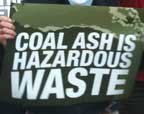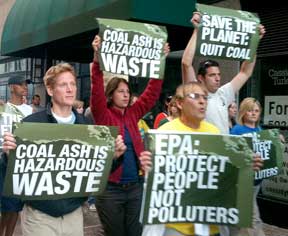Long-overdue rules to limit coal ash exposure coming after court settlement

In response to legal action by a broad coalition of national and local groups, the U.S. Environmental Protection Agency must finalize first-ever federal standards for the disposal of coal ash by December 19, 2014.
The settlement does not dictate the content of the final regulation, but gives the agency a deadline to finalize standards after years of delay.
"The state of Kentucky regulates the operation of municipal garbage dumps but says nothing about the disposal of coal ash," said KFTC member Mary Love. "I applaud the EPA’s decision to finally set nationwide rules for the disposal of this dangerous waste stream.”
The settlement was filed late yesterday in response to a lawsuit brought in 2012 by Earthjustice on behalf of Appalachian Voices (NC); Chesapeake Climate Action Network (MD); Environmental Integrity Project (D.C., PA); Moapa Band of Paiutes (NV); Montana Environmental Information Center; Physicians for Social Responsibility; Prairie Rivers Network (IL); Sierra Club; Southern Alliance for Clean Energy; Western North Carolina Alliance and KFTC.
Threats from coal ash ponds remain for generations. Peak pollution occurs between 78 to 105 years after ash pond operation begins.
In October, the U.S. District Court for the District of Columbia ruled that the EPA has a mandatory duty to review and revise its waste regulations under the Resource and Conservation Recovery Act. The EPA has never finalized any federal regulations for the disposal of coal ash – the nation’s second largest industrial waste stream.
Former EPA Secretary Lisa Jackson vowed to finalize coal ash regulations following a 2009 spill in Kingston, TN, where over a billion gallons of coal ash burst through a dam and damaged or destroyed two dozen homes and 300 acres of riverfront property.
In the aftermath of that disaster, the EPA proposed various regulatory options in May 2010 and held seven public hearings in August and September of that year. Environmental and public health groups, community organizations, Native American tribes and others generated more than 450,000 public comments on EPA’s proposed regulation, calling for the strongest protections under the law.
But since then, and despite coal ash contamination at more than 200 sites nationwide, the agency has failed to finalize the protections under pressure from industry, the White House and some members of Congress.
 Kentucky is fifth in the nation is coal ash generation. A 2011 study by Earthjustice found that Kentucky had 43 operating coal ash ponds, 21 of which exceed a height of 25 feet or impound more than 500 acre‐feet of ash. Professional engineers did not design 20 of the state’s 43 dams nor did they construct 27 of them.
Kentucky is fifth in the nation is coal ash generation. A 2011 study by Earthjustice found that Kentucky had 43 operating coal ash ponds, 21 of which exceed a height of 25 feet or impound more than 500 acre‐feet of ash. Professional engineers did not design 20 of the state’s 43 dams nor did they construct 27 of them.
Coal ash waste contains toxic chemicals and heavy metals such as arsenic and lead – pollutants that cause cancer, birth defects, reproductive problems, damage to the nervous system and kidneys, and learning disabilities in children. The EPA estimates that up to 1 in 50 nearby residents could get cancer from exposure to contaminants in poorly stored coal ash. Other health effects may include damage to vital organs and the central nervous system, especially in children.
For that reason, KFTC members have called on the EPA to adopt standards that would treat coal ash as the hazardous waste that it is.
One coal ash waste area of concern is in Louisville: "Since the mid-1950s, LG&E’s Cane Run Generating Station has been dumping its coal ash in an unlined pit dug 200 feet from the Ohio River. That coal ash pile is now over 100 feet tall and ¼ mile long," said Love.
A copy of the settlement can be found HERE.
Recent News
Kentucky’s past legislative session showed alarming trend toward government secrecy
Churchill Downs takes more than it gives. That's why the Kentucky Derby is a no-go for me
‘We must never forget.’ Kentucky town installs markers for lynching victims.
Featured Posts
TJC Rolling Out The Vote Tour – a KFTC Reflection Essay
KFTC Voter Empowerment Contractor Reflection Essay
Voting is Power
Archives
- Home
- |
- Sitemap
- |
- Get Involved
- |
- Privacy Policy
- |
- Press
- |
- About
- |
- Bill Tracker
- |
- Contact
- |
- Links
- |
- RSS


Add new comment